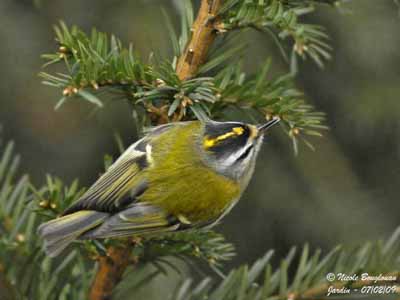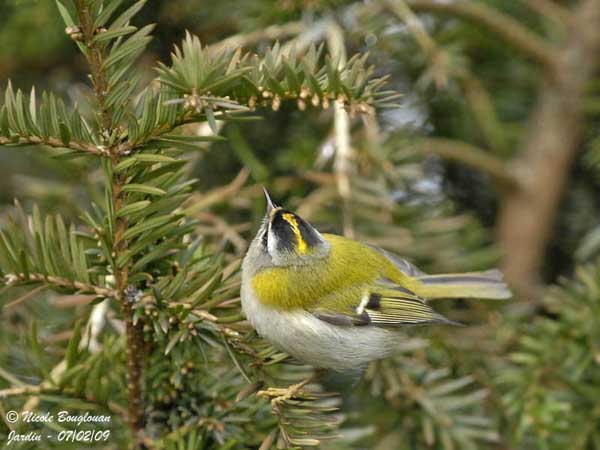
Common Firecrest
Regulus ignicapilla
Passeriforme Order – Regulidae Family
BIOMETRICS :
Length : 9 cm
Weight : 5-7 g
DESCRIPTION :
Common Firecrest is a tiny gem always moving along the small branches and twigs, searching for food while calling softly.
PROTECTION / THREATS / STATUS:
Common Firecrest is locally common and this species is not threatened at this moment.
These birds are vulnerable to hard winters but populations usually recover from large declines within two or three years.
Common Firecrest is very similar to Goldcrest, but each species has its peculiar feeding behaviour and different physical features.
Fr : Roitelet triple bandeau
All : Sommergoldhähnchen
Esp : Reyezuelo Listado
Ital: Fiorrancino
Nd: Vuurgoudhaantje
Russe: Красноголовый королек
Sd: Brandkronad kungsfågel
Photographs and text by Nicole Bouglouan
Sources:
HANDBOOK OF THE BIRDS OF THE WORLD Vol 11 by Josep del Hoyo, Andrew Elliott and David Christie - Lynx Edicions - ISBN: 849655306X
THE HANDBOOK OF BIRD IDENTIFICATION FOR EUROPE AND THE WESTERN PALEARCTIC by Mark Beaman, Steve Madge - C.Helm - ISBN: 0713639601
THE COMPLETE BOOK OF BRITISH BIRDS – Written by “Royal Society for the Protection of Birds” experts - Préface de Magnus Magnusson - Michael Cady- Rob Hume Editors - ISBN: 0749509112

Adult male has olive green upperparts and whitish underparts. It shows yellow-bronze shoulder patch. On the wings, the flight feathers are more or less edged yellow-green. We can see two white wing bars and black patch at secondary’s base.
On the underparts, the throat is creamy-white. Belly is pale greyish.
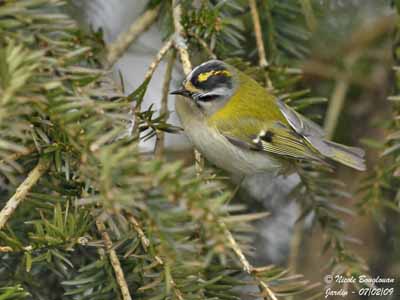
The head shows striking pattern on pale grey plumage. Crown is black with conspicuous orange median stripe, ending in bright yellow on the rear crown. Forehead is yellowish-buff. We can see a broad white supercilium and a finer white crescent below the eye. Lores are black, followed by black eye-line ending on the ear-coverts. We can also see a fine black malar stripe.
The thin pointed bill is black. Eyes are dark brown to black. Legs and feet are brown.
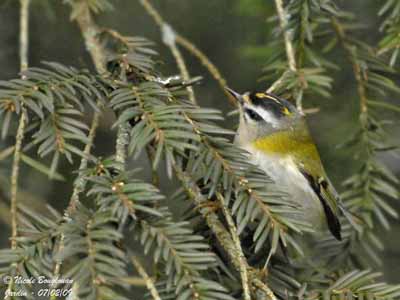
Female is almost similar to male, but she has duller yellowish line on the crown, and she often lacks this pattern.
Juvenile is duller in plumage than adults and lacks the conspicuous head pattern.
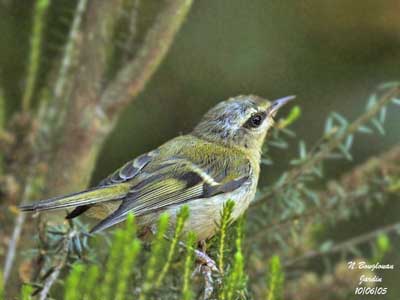
We find four subspecies sharing the wide range.
R.i. ignicapilla, from W and C Europe and Asia Minor;
R.i. balearicus, from Balearic Islands and North Africa;
R.i. tauricus, from Crimea;
R.i. caucasius, from W Caucasus.
VOICE: SOUNDS BY XENO-CANTO
Common Firecrest’s call is a slow “ze-ze-zeep”, or a single “zeep” sometimes repeated.
Song is a repeated crescendo of one note, accelerating towards the end “zi-zi-zi-zizizit”.
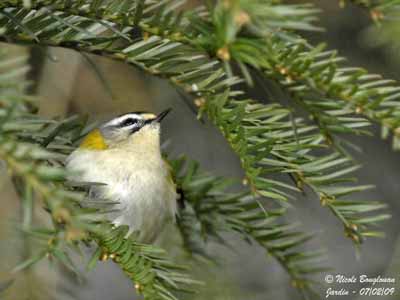
HABITAT:
Common Firecrest frequents mainly coniferous forests (spruce and fir). It may also be common in mixed woodlands, according to the range. It has a preference for oak trees (Quercus).
This species is usually found in lowlands up to 1000 metres of elevation, but higher in North Africa, up to 1600 metres.
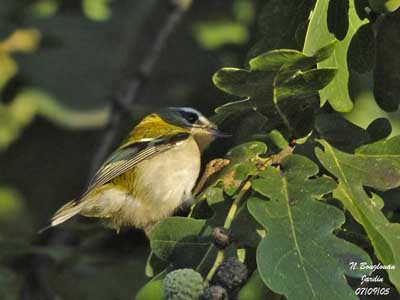
RANGE:
Common Firecrest ranges in Europe, from Western Europe, Balearic Islands and North Africa to Crimea and Western Caucasus.
BEHAVIOUR:
Common Firecrest feeds mainly on insects such as Arthropods, aphids and spiders. The largest preys are beaten against a branch before to be eaten.
It forages mainly on the upper side of leaves and branches, rarely in dense foliage.
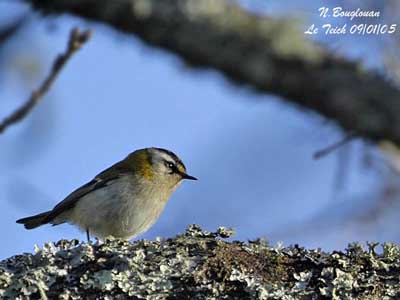
It hovers at tip of branches, picking the preys while moving continuously. It also takes the insects trapped in spider webs by hovering rapidly close to the web. It may catch large spiders too.
Although the birds avoids direct contact with the large spider webs, it has been found stuck in a spider web, motionless or dead.
It forages in small groups outside the breeding season.
During the year, Common Firecrest is less aggressive than in reproduction period, and it spends its time foraging and feeding. However, it may perform some threat behaviour by displaying the paler underwings.
In winter, during the cold periods, the birds rest and sleep in close contact for keeping warm.

During the courtship displays, the bright-coloured crest plays an important role.
In territorial behaviour, the crest-raising is often accompanied by song display. The male performs “forwards-displays” with the bill pointed towards the opponent. The orange crest and the black and white head pattern are strongly exhibited.
Common Firecrest is migratory, but the birds living in the southern parts of the range are resident.
FLIGHT:
Common Firecrest hovers when foraging in bushes and trees. At this moment, the bird performs intense hovering and is able to perform long and sustained flight, and zigzagging sequences when attacking some preys.
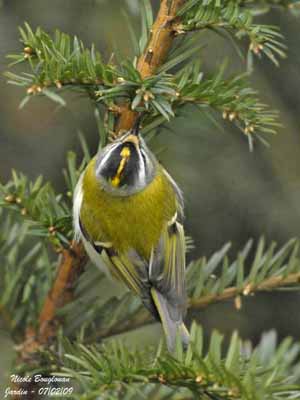
REPRODUCTION:
Breeding season occurs between April and August. This species produces two broods per season.
The nest-site is usually in mature conifer trees such as spruces and firs, and in oak trees covered with creepers or ivy in deciduous habitat.
The nest is an open cup with small entrance at top. It is made with three layers of varied materials. Outer layer is made of moss and lichens, fixed with spider and cocoons of spiders and caterpillars. The middle layer is made with flimsy mosses and a few lichens. The interior is lined with softer materials such as feathers and hair, and some plant down. Some feathers are added on the rim for more perfect mimicry with the environment.
Female lays 6 to 13 eggs. Incubation lasts about two weeks, by female alone. She is fed on nest by the male. The young fledge about three weeks after hatching and they are fed by both parents for two weeks more.
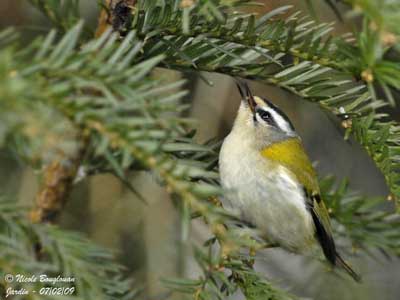
DIET:
Common Firecrest feeds mainly on Arthropods, aphids and spiders. It gleans into clear foliage, preferring the upper side of leaves and branches. It may catch large spiders.
